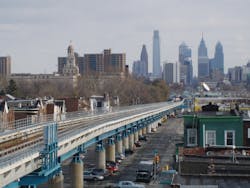The Impact of Aging Infrastructure
As a part of National Infrastructure Week, the American Public Transportation Association (APTA) held a briefing that explored the current state of the nation's aging public transportation infrastructure. Acting APTA President & CEO Richard White said, “The industry is a victim of its own success,” as many properties have experienced tremendous growth while struggling to maintain aging infrastructure.
In the San Francisco region, San Francisco Municipal Transportation Agency (SFMTA) Director of Transportation Ed Reiskin said they are expecting a 15 percent increase in population and a 25 percent growth in employment within the next 20 years. “We’re feeling the strain of the growth today but we need to be ready to meet that need,” he said.
The Chicago Transit Authority (CTA) saw a new record for ridership in 2015 and it continues to grow, and Southeastern Pennsylvania Transportation Authority (SEPTA) saw record ridership and a 52 percent increase in its rail ridership.
The Growing Backlog
In the past few months there has been a focus on what the Washington Metropolitan Transit Authority (Metro) has been facing in terms of aging infrastructure since the system’s complete shutdown of its Metrorail system in March, followed by a service disruption at Bay Area Rapid Transit (BART) that led to a Twitter exchange that brought its attention to the national level.
While there has been a lot of national attention brought to those agencies the past few months, other transit agency leaders pointed out the similar challenges they’re all facing.
White said there is an $86 billion backlog in deferred capital needs for public transportation, with 40 percent of the buses and 20 percent of rail in marginal or poor condition. The reoccurring cost is $43 billion to maintain the infrastructure, which is 2-1/2 times the annual amount spent today. The American Society of Civil Engineers rates transit infrastructure a D.
Greater Cleveland Regional Transit Authority CEO/General Manager Joseph Calabrese said their system has the dubious honor of being the oldest fleet in the nation. The 108-car rail fleet is safe, but he stressed that adequate funding is needed to maintain its safety and reliability.
Reiskin said they do what they need to do to keep SFMTA operating safe, but it’s not where it needs to be. They are facing a $2.5 billion backlog in terms of state of good repair and pointed out that while the big numbers are abstract, they have a very real impact. “A switch down on the subway can impact thousands of people,” he said.
Dorval Carter, president of the Chicago Transit Authority, talked of one of their projects this year, adding elevators to a station that was built back in 1897. They are continually facing the challenges to replacing aging infrastructure and they will need federal and state dollars to meet the need of backlog infrastructure investments.
The Port Authority of Allegheny County has 79 bridges, 29 of which are for rail and seven are more than 100 years old. There are also 2 inclines that are more than 130 years old. Its CEO, Ellen McLean, said it’s hard to balance between the high cost of capital repair and expansion. While they can sustain the levels of service they have, they can’t afford to improve or expand.
While the briefing included numerous representatives from large, legacy systems, Jeff Hamm, Executive Director/CEO, Clark County Public Transportation Benefit Authority (C-Tran), stressed the problem stretches across the country, impacting transportation providers of all sizes. “It’s been particularly difficult in small and rural communities that have seen a reduction in funding.”
Future Funding
White said it is time to build awareness on the importance of rebuilding, renewing and expanding one of America’s most valuable assets: the nation’s transportation systems.
With inadequate funding, the challenges transit systems are facing shouldn’t be surprising, Wiedefield said. Speaking of Metro, he said, “Our once proud system has become the poster child of what a lack of funding does.”
Resikin said, “Infrastructure is not very exciting. When it’s working fine, people don’t notice it, when there are failures, they’re in the headlines.” He added, “I hope to keep infrastructure a boring topic.”
